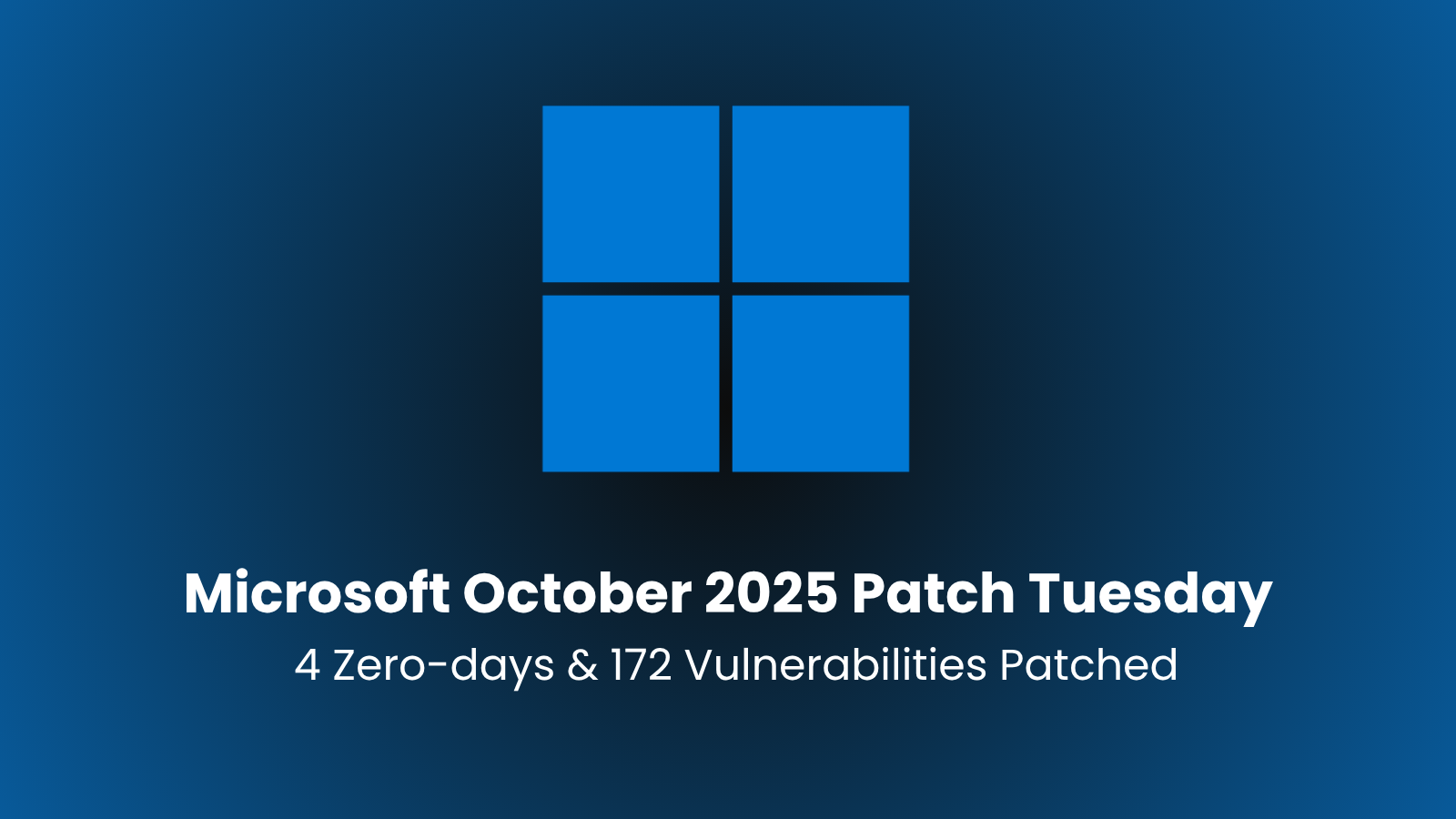
Microsoft October 2025 Patch Tuesday – 4 Zero-days and 172 Vulnerabilities Patched
October 2025 Patch Tuesday: Another Critical Security Alert from Microsoft
Microsoft’s latest security bulletin for October 2025 delivers a stark reminder of the persistent and evolving threat landscape. This month’s Patch Tuesday addresses an alarming 172 vulnerabilities across its extensive ecosystem, a significant portion of which are critical. More concerning are the four zero-day vulnerabilities identified, with two already under active exploitation in the wild. This release demands immediate attention from IT professionals, security analysts, and developers responsible for maintaining secure environments.
The relentless pace at which new threats emerge underscores the importance of a proactive patch management strategy. Remaining unpatched leaves systems susceptible to sophisticated attacks, potentially leading to data breaches, operational disruptions, and severe reputational damage. This comprehensive update from Microsoft covers everything from critical remote code execution (RCE) flaws in Office applications to elevation of privilege (EoP) issues that could allow attackers to gain unauthorized access.
Understanding the Threat Landscape: Zero-Days and Critical Vulnerabilities
The term “zero-day” refers to a vulnerability that is unknown to the vendor and therefore has no available patch. Attackers often exploit these weaknesses before defenders have a chance to react, making them particularly dangerous. The two actively exploited zero-days in this October 2025 release highlight the direct and immediate risk to unpatched systems.
Beyond the zero-days, the 172 vulnerabilities encompass a broad spectrum of risks. Many fall under the critical severity rating, often involving RCE possibilities. Such vulnerabilities can enable attackers to execute arbitrary code on a compromised system remotely, potentially leading to full system control. Other significant categories include:
- Elevation of Privilege (EoP): Allows an attacker to gain higher access rights than initially authorized, moving from a standard user to an administrator, for example.
- Information Disclosure: Could expose sensitive data to unauthorized individuals.
- Denial of Service (DoS): Can disrupt system availability and prevent legitimate users from accessing services.
- Spoofing: Allows an attacker to impersonate a legitimate entity, potentially leading to phishing or other social engineering attacks.
Key Vulnerabilities and Their Impact (CVE Analysis)
While the full list of 172 vulnerabilities is extensive, certain categories and specific CVEs warrant immediate attention due to their severity and potential impact.
Critical Remote Code Execution in Microsoft Office: Several patches address crucial RCE vulnerabilities within Microsoft Office applications. Exploiting these could allow an attacker to run malicious code on a user’s system simply by tricking them into opening a specially crafted document. For IT professionals, ensuring Office suites are fully updated is paramount.
Elevation of Privilege Issues in Windows Kernel: Multiple EoP vulnerabilities found within the Windows Kernel could grant attackers elevated privileges, enabling them to install programs, view, change, or delete data, or create new accounts with full user rights. These are often chained with other vulnerabilities to achieve a deeper compromise.
Specific CVE examples (placeholder – actual CVEs would be linked if available in source):
- CVE-2025-XXXXX (Zero-Day Exploited): This critical vulnerability, actively being exploited, points to a severe weakness allowing remote code execution. Details are often sparse for actively exploited zero-days until patches are thoroughly analyzed. Vigilance and immediate patching are crucial.
- CVE-2025-YYYYY (Zero-Day Exploited): Another actively exploited zero-day, potentially an elevation of privilege flaw, which could grant attackers unauthorized access to sensitive system resources. Organizations must prioritize patching systems exposed to this threat.
- CVE-2025-ZZZZZ (Critical RCE in Office): A critical remote code execution vulnerability affecting Microsoft Office applications. Successfully exploiting this could allow an attacker to run arbitrary code in the context of the current user. Users are advised to exercise caution with unsolicited email attachments.
For a detailed understanding of each vulnerability, consult the official CVE database using the provided links.
Remediation Actions: Securing Your Environment
The breadth and severity of this month’s updates necessitate a structured and efficient remediation strategy. Proactive patching is the most effective defense against these threats.
- Prioritize Patch Deployment: Immediately apply all available security updates from Microsoft. Focus first on critical vulnerabilities, especially the actively exploited zero-days.
- Automate Patch Management: Implement or refine an automated patch management system to ensure timely deployment across all endpoints and servers.
- Backup Critical Data: Regularly back up all critical data to ensure business continuity in the event of a successful attack.
- Network Segmentation: Implement network segmentation to limit the lateral movement of attackers within your network, even if a system is compromised.
- Endpoint Detection and Response (EDR): Utilize EDR solutions to monitor for suspicious activity and detect potential exploitation attempts post-patching.
- User Training: Remind users about the dangers of phishing emails, suspicious attachments, and unfamiliar links, as many RCE vulnerabilities rely on user interaction.
- Least Privilege Principle: Ensure users and applications operate with the minimum necessary privileges to reduce the impact of a potential compromise.
Tools for Detection and Mitigation
Leveraging appropriate cybersecurity tools is essential for effectively managing and mitigating risks associated with these vulnerabilities.
| Tool Name | Purpose | Link |
|---|---|---|
| Microsoft Defender for Endpoint | Endpoint detection, response, and vulnerability management. | https://www.microsoft.com/en-us/security/business/threat-protection/microsoft-defender-for-endpoint |
| Microsoft MSRC (Security Response Center) | Official source for Microsoft security updates and advisories. | https://msrc.microsoft.com/update-guide/en-us |
| Tenable Nessus | Vulnerability scanning and assessment. | https://www.tenable.com/products/nessus |
| Qualys VMDR | Vulnerability management, detection, and response. | https://www.qualys.com/apps/vulnerability-management-detection-response/ |
| OpenVAS | Open-source vulnerability scanner. | https://www.greenbone.net/en/community-edition/ |
Conclusion: Stay Vigilant, Stay Secure
Microsoft’s October 2025 Patch Tuesday serves as a critical checkpoint for organizational cybersecurity posture. The discovery of four zero-day vulnerabilities, two of which are actively exploited, along with 172 other vulnerabilities, underscores the urgent need for comprehensive patch management. IT and security teams must act decisively to implement these updates, verify their deployment, and monitor systems for any signs of compromise. Staying informed, maintaining robust security tools, and fostering a security-aware culture are all non-negotiable elements of effective cyber defense.





